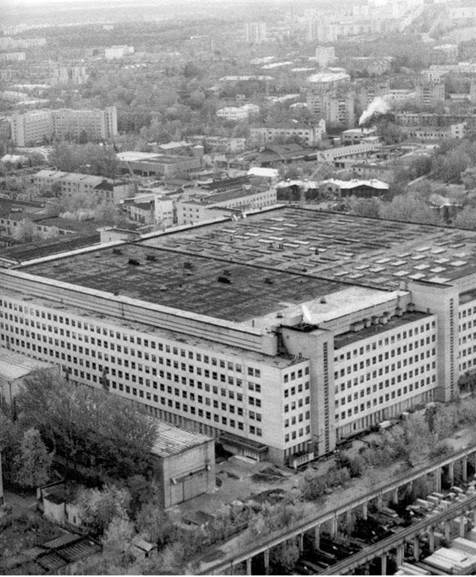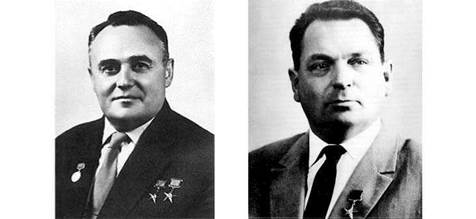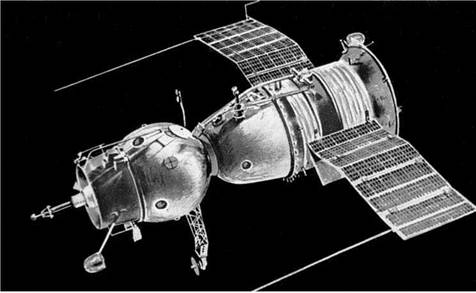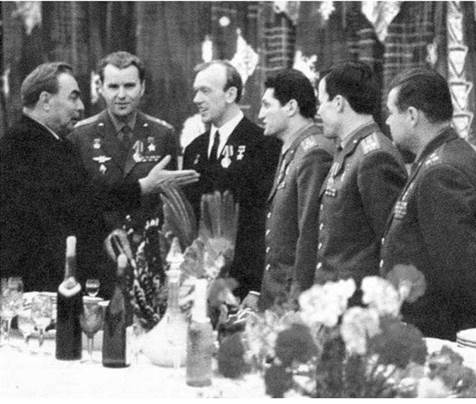From Almaz to Salyut
EARLY DAYS
Special Design Bureau 1, OKB-1,[3] is situated some 25 km northeast of the centre of Moscow in Podlipok, Kaliningrad (renamed Korolev in 1997), and it played a key role in the Soviet manned space programme: it designed the first satellites, the first lunar and interplanetary probes, and the Vostok spacecraft that carried the first man into orbit. In the years that followed those early achievements, it defined the major strands of the manned space programme.
The leader of OKB-1, and the main driving force of Soviet cosmonautics, was the legendary Chief Designer Sergey Pavlovich Korolev. After Korolev’s death during what had been expected to be routine surgery in January 1966, he was succeeded by his deputy Vasiliy Pavlovich Mishin, a rocket engineer who had worked closely with Korolev since 1945. Mishin promptly reorganised the work force of more than 60,000 employees, and on 6 March 1966, at the direction of the Ministry of General Machine Building (MOM), and no doubt in an effort to confuse spies, OKB-1 was renamed the Central Design Bureau of Experimental Machine Building (TsKBEM).
Mishin inherited from Korolev the task of completing the development of the new manned spacecraft named Soyuz (‘Союз’, meaning ‘Union’), and using this for the L1 programme in which two cosmonauts were to fly in a very high orbit that looped around the far side of the Moon before returning to Earth. But for Mishin the most important task was the development of the giant N1 rocket for the L3 programme to land a Soviet cosmonaut on the lunar surface.
The development of the Soyuz proved to be more difficult than expected, with a series of unmanned test flights revealing a variety of problems, but in April 1967 it was decided to proceed with the first manned test in which one spacecraft would be launched into orbit with a single cosmonaut and a second spacecraft with a
|
The TsKBEM building at Kaliningrad, Moscow. |
Early days 3
|
|
The founder of the Soviet space programme, Sergey Korolev (left) and his successor Vasiliy Mishin, who was Chief Designer of the TsKBEM from 1966 to 1974.
|
|
The Soyuz spacecraft was the workhorse of the Soviet manned space programme. On the left is the orbital module with the active docking probe, then the descent module with the crew cabin, and finally the propulsion module containing the main engine and solar panels.
|
Leonid Brezhnyev with the crews of the Soyuz 4/5 joint mission. |
crew of three would follow the next day. The two spacecraft were to rendezvous and dock, and two of the cosmonauts were to cross from one vehicle to the other by spacewalking. However, Soyuz 1, flown by Vladimir Komarov, ran into difficulties immediately on entering orbit. First, one of two solar panels failed to deploy and this resulted in problems with the star sensor, which made it difficult for the vehicle to maintain the desired orientation in space. The State Commission at the Baykonur cosmodrome in Kazakhstan cancelled the launch of Soyuz 2. After overcoming numerous technical problems, Komarov finally succeeded in orientating his craft and made the de-orbit burn. Unfortunately, the parachute failed to deploy and the descent module hit the ground at great speed and Komarov perished.
When flights were resumed in October 1968, Soyuz 2 was launched unmanned. Georgiy Beregovoy, launched the next day in Soyuz 3, performed a rendezvous, but could not achieve a docking.
When two manned Soyuz spacecraft were finally able to dock in January 1969, Yevgeniy Khrunov and Aleksey Yeliseyev performed a spacewalk to transfer from Soyuz 5 to Soyuz 4, then returned to Earth with Vladimir Shatalov. When Boris Volynov attempted to land in Soyuz 5 the next day, the propulsion module failed to
Chelomey and the Kremlin 5
separate from the descent module, causing the vehicle to start its re-entry with the hatch – as opposed to the heat shield – facing in the direction of flight. Fortunately, the connections between two modules were severed by the heat before the descent module suffered damage, and the capsule rotated into the safe orientation. However, the off-nominal re-entry caused the capsule to descend 600 km from the planned recovery point and the impact was so violent that Volynov suffered several broken front teeth.
The docking of two manned spacecraft was one of the rare Soviet achievements during the race to the Moon. But the success of Apollo 8 in performing 10 orbits around the Moon in December 1968 had rendered politically pointless the simpler circumlunar mission for which the L1 version of Korolev’s spacecraft had been designed.
When Apollo 11 landed on the Moon in July 1969, the Americans won the race to the Moon, and the mood of the Kremlin was further diminished by two failures of the N1 rocket. In an attempt to once again impress the Soviet nation, and indeed the world, it was decided that the next mission should included three manned spacecraft with a total of seven cosmonauts.
Accordingly on successive days in October 1969 Georgiy Shonin and Valeriy Kubasov were launched on Soyuz 6, Anatoliy Filipchenko, Vladislav Volkov and Viktor Gorbatko were launched on Soyuz 7, and Vladimir Shatalov and Aleksey Yeliseyev – both of whom were veterans from the successful Soyuz 4/5 docking – were launched on Soyuz 8. Once all three spacecraft had rendezvoused in space, the crew of Soyuz 6 were to film Soyuz 8 docking with Soyuz 7. This time, however, it was not intended that any cosmonauts should make a spacewalk. Unfortunately, the Igla automatic rendezvous system onboard Soyuz 8 malfunctioned, and despite four manual attempts Shatalov was unable to complete the approach. Pursuing their own programme, Shonin and Kubasov performed the first vacuum-welding operation in space, then returned to Earth, followed in turn by Soyuz 7 and 8 over the next two days. As much as the Kremlin and TASS, the official news agency, had portrayed this ‘group flight’ as another achievement of Soviet cosmonautics, Mishin and his engineers were disappointed.
Mishin’s dilemma was that because the Soyuz was to be a ‘universal’ spacecraft, delays in perfecting it were holding up the programmes that were to exploit it, some of which, including the N1-L3 lunar landing programme, were already years behind schedule.














